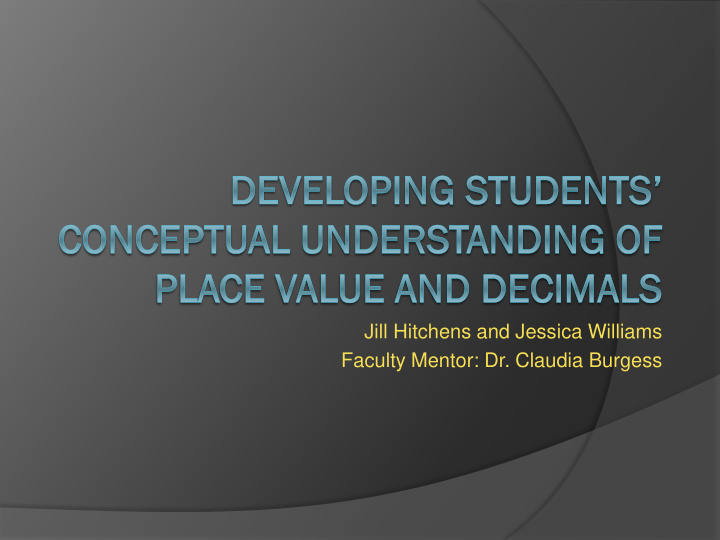



Jill Hitchens and Jessica Williams Faculty Mentor: Dr. Claudia Burgess
Common Misconceptions Apply knowledge of whole numbers to decimals. (Durkin & Rittle-Johnson, 2014). Ex. students may believe that 0.45 is greater than 0.8 because 45 is greater than 8 Believe if there is a zero at the end of a decimal number, that the value increases (Durkin & Rittle-Johnson, 2014) Ex. students might believe that 0.89 has a lesser value than 0.8900 Students are often told to “line up the decimal point ” ( Ashlock, 2010). Ex. believing that 0.7 + 0.7 = 0.14
Purpose The purpose of this study was to examine students’ thinking about whole number place value and the base ten system and how their understandings of these topics influenced their learning of decimals and decimal computations.
Research Question How can students’ proficiency be improved in the areas of whole number place value, decimal place value, and decimal computation?
Five Strands of Mathematical Proficiency Conceptual Procedural Strategic Adaptive Productive Understanding Fluency Competence Reasoning Disposition Habitual inclination to Skill in see Capacity for Comprehen- carrying out Ability to mathematics logical sion of formulate, as sensible, procedures thought, useful, and mathematical flexibly, represent, reflection, concepts, accurately, and solve worthwhile, explanation, operations, efficiently, mathematical coupled with and and relations and problems a belief in justification diligence and appropriately one’s own efficacy (National Research Council, 2001, p. 116)
Additional Educational Research Build upon students' prior knowledge (Carpenter et al., 2015) Build upon students' knowledge of place value to develop their understanding of decimals (Ashlock, 2010) Use visual models to illustrate the conceptual structure of decimals (National Governors Association & Council of Chief State School Officers, 2010) Use inquiry-oriented instruction (Reys et al., 2014) .
Learning Trajectory for Place Value and Decimals • Recognize a digit in one place represents ten times what it represents in the place to its right 4.NBT.1 • Read and write decimals to thousandths using expanded notation and place value. 5.NBT.3.a 5.NBT.3.b • Compare decimals to thousandths using values of digits • Recognize a digit in one place represents ten times what it represents in the place to the right and 1/10th of what it represents to the left. 5.NBT.1 • Add, subtract, multiply, and divide decimals to hundredths and explain. 5.NBT.7 • • • • •
Participants 4 students entering fifth grade in fall 2015 Pseudonyms: Alex, Bethany, Christina, Daniel Participated in: 30-minute initial interview Seven 1-hour tutoring sessions 30-minute post interview Participation Rate: 100%
PATHWAYS Cycle of Integrated Teaching and Research Analyze student assessment data Gather written and video Establish student recorded data learning goals from interactions with students Pose selected Select tasks to tasks to groups move students' of two or four thinking forward students
Sample Interview Questions 1. What would be the value of the next block to the left [of the thousands cube]? 2. Add 2.4 + 10.03 3. Subtract 12.0 – 0.145 4. Multiply 0.2 x 3
Initial Assessment Results Students had a wide range of abilities Demonstrated procedural fluency without conceptual understanding
Initial Assessment Results Christina Bethany Alex Daniel Write 347.392 in expanded form 347.392
Instructional Cluster 1 Understanding whole number and decimal place value Use manipulatives to represent various numbers Discover patterns in base ten system
Instructional Cluster 2 Used manipulatives Adding and subtracting decimals Concepts of regrouping Differentiated instruction Small group work
Instructional Cluster 3 Multiplication of a whole number by a decimal, ex. 2 x 0.3 Open-ended word problems Represented numbers with drawings Explained reasoning
Initial and Post Interview Results Daniel Christina Bethany Alex 1 2 3 4 5 Initial Interview Post Interview
Results Alex Christina and Daniel were able to accurately read the decimals on the post interview. Bethany
Reflection and Discussion An understanding of whole numbers is essential Initial assessment Do not move through standards too quickly Multiple experiences with each concept Assessment should match instruction method Manipulatives
References Asklock, R.B. (2010). Error patterns in computation: Using error patterns to help each student learn (10th ed.). Upper Saddle River, NJ: Pearson. Carpenter, T.P., Fennema, E., Franke, M.L., Levi, L., & Empson, S.B. (2015). Children's mathematics: Cognitively guided instruction (2nd ed.). Portsmouth, NH: Heinemann. Confrey, J., Nguyen, K.H., Lee, K., Panorkou, N., Corley, A.K., & Maloney, A.P. (2012). TurnOnCCMath.net: Learning trajectories for the K-8 Common Core Math Standards . Retrieved from https://www.turnonccmath.net Durkin, K., & Rittle-Johnson, B. (2014). Diagnosing misconceptions: Revealing changing decimal fraction knowledge. Learning and Instruction , 22(3), 21-29. National Research Council. (2001) Adding it Up: Helping Children Learn Mathematics . J. Kilpatrick, J. Swafford, and B. Findell (Eds.). Mathematics Learning Study Committee, Center for Education, Division of Behavioral and Social Sciences and Education. Washington, DC: National Academy Press. Reys, R.E., Lindquist, M., Lambdin, D.V., & Smith, N.L. (2014). Helping children learn mathematics (11th ed.). Hoboken, NJ: Wiley.
Recommend
More recommend